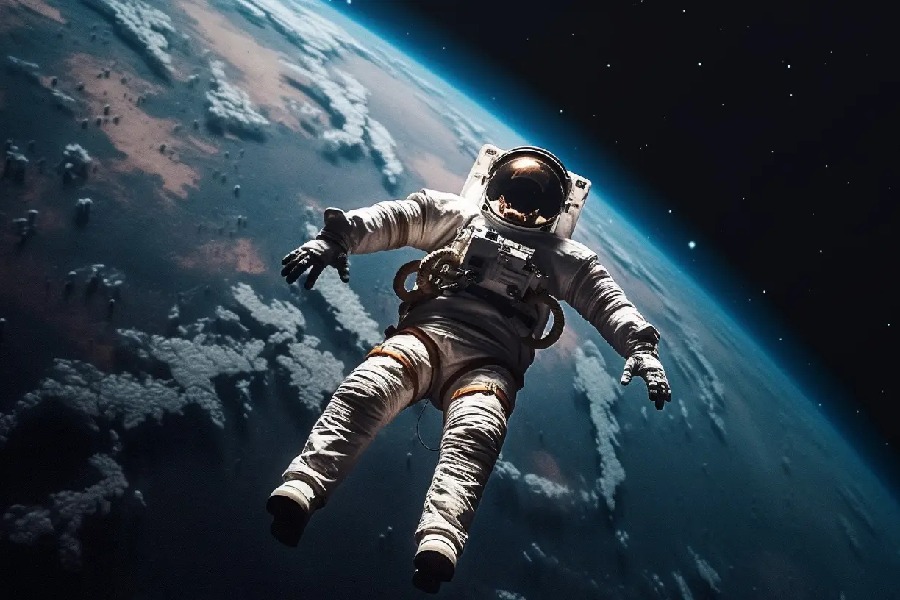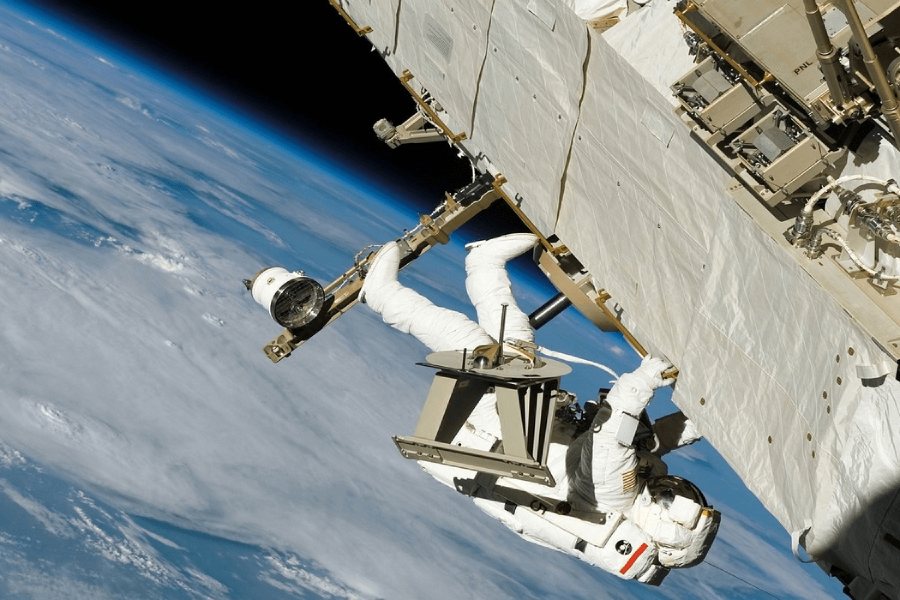The International Space Station is one of the greatest marvels of science that orbits our Earth. It allows our astronauts to spend time in space doing various research. But how long do astronauts stay in space station?
This article will examine the average length of an ISS astronaut crew visit while diving into the impacts of extended missions. Learn how they sleep, eat, exercise and work while circling Earth continuously.
From training for the launch to readapting after the return trip, we’ll uncover what a lengthy stay aboard this pinnacle of scientific achievement means for today’s space travelers and the interplanetary explorers of tomorrow. Let’s get started!

How Long Do Astronauts Stay in Space Station?
The duration of an astronaut’s stay on the International Space Station (ISS) can vary, but typical missions last about six months. Expeditions to the ISS involve a period of preparation, travel to the station, and then a stay aboard the ISS itself.
The six-month timeframe allows scientists to study the long-term effects of microgravity on the human body. It also enables conducting various experiments in the unique environment of space for an extended period.
However, there have been shorter and longer missions depending on the objectives. The specific goals of the various space agencies involved also dictate expedition lengths.
Standard Length of Astronaut Missions
So, how long do astronauts stay in space station? As mentioned, the typical amount of time astronauts spend on missions to the International Space Station (ISS) is around six months.
Nevertheless, stays of approximately half a year allow for meaningful scientific research. Most crew rotations last four to seven months to balance research needs with human health factors.
What impacts mission length?
A pivotal question scientists aim to address is: How long can you live in space station? This inquiry hinges on various factors, compelling researchers to explore avenues for prolonging this duration. Let’s examine the elements that govern this timeframe.
Specific research goals
Lengths vary based on the experiments being conducted. Shorter visits of two to three months support focused research projects. Longer missions of close to one year help iterative studies.
For example, growing vegetables in space may require four to six-month crop cycles. Studying worms or cells often takes a whole year to collect enough data. The science objectives set experiment timeframes.
Space agency direction
NASA, ESA, Roscosmos, and other space agencies meticulously strategize mission durations in alignment with their organizational objectives. These timelines are intricately intertwined with the fluctuating cycles of government funding, which significantly influence their execution.
The allocation of agency budgets is pivotal in determining crew and cargo transportation capabilities. With greater financial support, agencies can sustain astronauts for extended expeditions, enriching the scope and depth of exploration. Additionally, overarching priorities, such as the ambitious goals of reaching the Moon and Mars, are crucial in shaping the targets for orbit duration.
Crew health
Astronauts undergo extensive training, but there are physiological limits. Factors like bone density loss, vision changes, and radiation levels affect mission lengths. Yet, many questions remain unanswered.
What is the impact of spending a full year in space on the risk of illness? Are current countermeasures sufficient for missions lasting over a year? NASA is investigating one-year stays to gather more insights.
These missions will yield crucial data necessary to evaluate the possibility of longer-duration space travel. They will also aid in refining medical support and health precautions. Understanding the effects of prolonged exposure to space will benefit future missions.

Historic Space Endurance Records
Throughout history, selected space travelers have embarked on exceptionally long stays aboard stations. Cosmonaut Valeri Polyakov holds the absolute record at 437 days aboard Mir in 1994-1995. As missions extend past typical 6-month rotations, new milestones continue to be met, proving the boundaries of human space resilience.
Vande Hei’s incredible 355 days in space
In 2022, NASA astronaut Mark Vande Hei set a new US record for the single longest spaceflight at 355 days aboard the International Space Station (ISS). Launched in April 2021, Vande Hei secured his place in history on his return in March 2022 after nearly 12 full months in orbit.
Upon splashdown, Vande Hei achieved the longest single spaceflight by any NASA astronaut, finally surpassing Scott Kelly’s 340-day record set in 2016. Kelly still retains the record for total accumulated days in space over a career.
Significance for future exploration goals
Vande Hei’s year-long endurance mission provided important data to NASA on the impacts of extended-duration human spaceflight. This will enable critical insights to plan three-year roundtrip missions to Mars in future decades.
The 2022 mission also facilitated hundreds of great research achievements aboard ISS itself. All made possible by Vande Hei’s record-setting participation, enabling continuity.
Sergei Krikalev holds previous record
Sergei Krikalev, a Russian cosmonaut, spent over 680 days aboard space stations, including Mir and ISS, through multiple missions during the 1990s and 2000s. His accumulated time officially remains the world record for most days in space at 803 days across six flights until today.
Interestingly, funding issues extended an intended five-month mission to 10 months in 1992 – showcasing the realities of space programs. Despite this, Krikalev maintained exceptional professionalism, leadership and scientific contributions throughout his pioneer career spanning decades.
Contrast with Vande Hei’s recent milestone
While Mark Vande Hei’s 355 days were outstanding and built US capabilities for Mars, Krikalev spanned multiple pioneering missions across eras of early space stations. Yet Vande Hei’s record-setting single flight laid the groundwork.
This groundwork was for future leaps beyond both one year and Krikalev’s marks. It enabled humans to live and work in space for longer durations continuously.
Vande Hei’s Six-Month Mission Aboard the ISS
NASA astronaut Mark Vande Hei spent six months aboard the International Space Station from September 2021 through March 2022. During his expedition, he participated in hundreds of scientific experiments and ongoing station maintenance duties.
Vande Hei carried out critical biomedical tests. For example, studies of microgravity’s long-term impact on balance, bones, and muscles. Also, blood, vision, the microbiome and radiation exposure. These aim to support longer Moon and Mars missions.
In addition, Vande Hei installed solar arrays and communications gear for future spacewalks. He also welcomed SpaceX and Russian vehicles for unloading payloads and supplies.
Objectives, experiments, and tasks accomplished during the six-month stay
During his record 355 consecutive days on the ISS, Vande Hei contributed to over 2,000 hours of science investigation. Objectives included testing 3D bioprinting of human tissue and growing chili peppers for supplemental fresh food.
Hei also assessed liquid handling in microgravity and analyzed head/eye movements using AR for balance research. Furthermore, he upgraded the orbiting laboratory’s toilet facilities and waste management systems.
Moreover, Hei captured imagery of Earth and volcanic eruptions from space. He also photographed tobacco plants to study gene expression changes in microgravity environments.
Insights into the challenges and experiences faced by Vande Hei
Mark Vande Hei has described several challenges he faced during his 353 days in space. Isolation from family and separation from loved ones for extended periods proved extremely taxing emotionally and mentally. Operating complex procedures and experiments in a harsh, dangerous setting with no opportunity for real-time guidance also posed difficulties.
Furthermore, risks like radiation, fire, changing blood pressure and vision constantly imperiled the astronaut’s health and safety. Yet, Vande Hei persevered, driven by his wonder toward space exploration and thirst for collecting new data to advance scientific progress.
Conclusion
How long do astronauts stay in space station? As we explored, it can vary from months to over a year, depending on mission objectives and physical limitations.
So, NASA’s one-year crew studies, the indispensable Soyuz transport, and the burgeoning promise of private launch partners all propel humankind’s reach into low Earth orbit. Expanding commercial capabilities, improved health safeguards, and global cooperation drive human spaceflight to unprecedented achievements.
Despite current constraints on space station stays, each crew’s contributions expand scientific horizons. That paves the way for longer, routine durations in the future.
